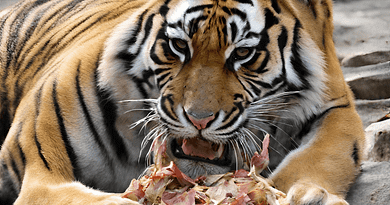What Do Baby Tigers Eat?
Introduction
Have you ever wondered what baby tigers eat? These adorable little cubs grow up to be fierce and powerful predators, but their journey starts with a special diet that helps them grow strong and healthy. In this article, we’ll explore what baby tigers eat, how their diet changes as they grow, and some interesting facts about their feeding habits. Let’s dive in and learn more about these fascinating creatures!
What Do Baby Tigers Eat in the Wild?
Mother’s Milk
When baby tigers, also known as cubs, are born, they rely entirely on their mother’s milk for nourishment. This milk is rich in nutrients and provides everything the cubs need to grow during their first few weeks of life.
Why Is Mother’s Milk Important?
- Nutrient-Rich: It contains all the essential nutrients, vitamins, and minerals.
- Immune Support: Helps build the cub’s immune system.
- Easy to Digest: Perfect for their tiny stomachs.
Transition to Solid Food
As the cubs grow, they begin to explore their surroundings and show interest in solid food. This usually happens around the age of 6 to 8 weeks.
What Solid Foods Do They Eat?
- Small Prey: Small animals like birds and rodents.
- Meat from Mother’s Hunt: Pieces of meat from the prey their mother catches.
Learning to Hunt
By the time they are a few months old, baby tigers start learning to hunt. This is a crucial skill for their survival in the wild.
How Do They Learn?
- Observation: Watching their mother hunt.
- Practice: Playing and practicing hunting techniques with their siblings.
What Do Baby Tigers Eat in Captivity?
Specially Formulated Diet
In zoos and wildlife sanctuaries, baby tigers are given a specially formulated diet to ensure they get all the nutrients they need.
What Does This Diet Include?
- Milk Replacers: Special milk formulas designed for tiger cubs.
- Ground Meat: Mixed with vitamins and minerals.
- Supplements: Additional vitamins and minerals to support growth.
Gradual Introduction to Solid Food
Just like in the wild, baby tigers in captivity are gradually introduced to solid food.
What Solid Foods Are Given?
- Chicken: Soft and easy to chew.
- Beef: Rich in protein.
- Fish: Provides essential fatty acids.
Interesting Facts About Baby Tigers’ Diet
Growth and Development
- Rapid Growth: Baby tigers grow quickly, gaining weight and strength.
- Weaning: They are usually weaned off their mother’s milk by the age of 6 months.
Social Feeding
- Sharing: Cubs often share their food with siblings.
- Playful Eating: Feeding time can be playful, with cubs pouncing and playing with their food.
Nutritional Needs
- High Protein: Essential for muscle development.
- Fat: Provides energy for their active lifestyle.
- Calcium: Important for strong bones and teeth.
FAQs About What Do Baby Tigers Eat
1. Do baby tigers eat plants?
No, baby tigers are carnivores, which means they eat meat. They do not eat plants.
2. How much do baby tigers eat?
Baby tigers start with small amounts of their mother’s milk and gradually increase their intake as they grow. By the time they are eating solid food, they consume several pounds of meat each day.
3. Can baby tigers eat fish?
Yes, baby tigers can eat fish. Fish provides essential fatty acids that are important for their growth and development.
4. When do baby tigers start hunting?
Baby tigers start learning to hunt around the age of 6 months. They practice by playing and observing their mother.
5. What happens if a baby tiger doesn’t get enough food?
If a baby tiger doesn’t get enough food, it can become weak and sick. Proper nutrition is crucial for their growth and survival.
Conclusion
Understanding what baby tigers eat helps us appreciate these magnificent creatures even more. From their early days of nursing on their mother’s milk to learning to hunt and eating solid food, their diet plays a vital role in their growth and development. Whether in the wild or in captivity, baby tigers need a balanced diet rich in nutrients to grow into the powerful predators we know and love. By learning about their diet, we can better protect and care for these incredible animals.
Further Reading:









